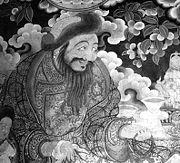- Gushi Khan
-
Güshi Khan
Güshi Khan (1607?-1655) est un Khan mongol, chef de la tribu des Qoshot. En 1640, il a envahi le Tibet et place le 5e Dalaï Lama comme chef temporel du Tibet en 1642.
Güshi Khan souhaitait vaincre le régent du Tibet, Tsangpa Desi, parce que ce dernier s'était allié à un ennemi de sa tribu mongole. Tsangpa Desi avait envahi Lhassa au début du XVIIe siècle, attaquant sauvagement les monastères de Drépung, Séra et Ganden. De plus, Güshi Khan avait intercepté une lettre du roi de Beri de l'est du Tibet adressée à Tsangpa Desi, décrivant un projet visant à détruire les monastères Gelugpa. Le chef mongol vainc le roi de Tsang qui gouvernait une grande partie du Tibet. Alors que les tensions augmentaient au Tibet, de nombreuses lettres furent échangées entre le Dalaï Lama, le Panchen Lama et le Karmapa. Le Panchen Lama et le Karmapa ont tenté d'apaiser les tensions dans l'est du Tibet.
Güshi Khan mit un terme aux troubles, et en 1642 le Dalaï Lama est intronisé dans le hall principal de Shigatsé comme dirigeant spirituel et politique du Tibet. Ainsi, Güshi Khan offrit à son enseignant spirituel, le 5e Dalaï Lama, la nation du Tibet. De cette façon, le chef mongol fait du Tibet son domaine, et établit le Dalaï Lama comme son dirigeant. Le Dalaï Lama unifia l'ensemble du Tibet, qui pendant des siècles avait connus des troubles et des conflits internes.
Cependant, le Dalaï Lama fut déçu par Güshi Khan car le chef mongol envahi l'est du Tibet, attaqua et dépouilla les habitants et les monastères de cette région. Les monastères de Séra, Ganden et Drépung de Lhassa se plaignirent également de la brutalité des agresseurs mongols.
En 1655, Güshi Khan meurt. Le Dalaï Lama nomma le fils de Güshi Khan Tenzin Dorje, comme nouveau khan mongol.
Précédé par Güshi Khan Suivi par - Khan du Khanat qoshot
1640-1655 -Tenzin Dorje - Portail du Tibet
- Portail du monde mongol
Catégories : Tibet | Khan mongol | Décès en 1655
Wikimedia Foundation. 2010.

